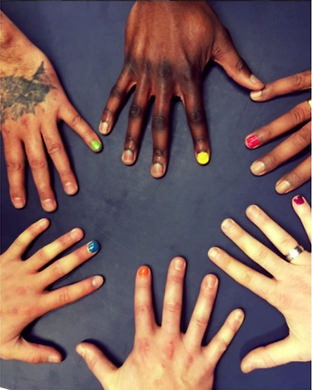Domestic violence line (24 hours) 1800 656 463; or the National Sexual Assault and Domestic Family Violence Counselling Service (24 hours) 1800 737 732; To report suspected child abuse or neglect, call the 24 hour Child Protection Helpline on 132 111; if you are in immediate danger call 000.
(Please note these resources are provided for reference only, we do not necessarily endorse all the views or content in each one, nor have we ‘vetted’ any volunteering suggestions).
A Catholic Response
In 2018 the Diocese of Broken Bay launched an exceptional kit on domestic violence from a Catholic perspective. It offers a great set of resources that help us understand the Church’s teachings on this issue as well as practical ways and approaches we can each take to deal with, recognise and manage this very serious and all too common issue. Find the Kit here.
 Conversation
Conversation
The National Community Attitudes Survey is conducted every four years, most recently in 2013, and measures how Australians across the country view issues related to violence against women. The most recent survey shows a ‘need to maintain an urgent focus on strengthening awareness and understanding of violence across the community and among young people in particular. The better people’s knowledge about the patterns and dynamics of violence, the less likely they are to hold violence supportive attitudes’.*
Therefore one of the most important and simple ways you can have a positive influence and help bring about more justice in this area is to have conversations with the people in your life about domestic violence, especially the young people you spend time with. Here are some of the things you can do in your conversations:
- promote women’s independence and decision-making in public life and relationships
- strengthen positive, equal and respectful relationships between and among women and men, girls and boys
- challenge behaviour and conversations that condone violence or disrespect of women
- promote and normalise gender equality in public and private life
- challenge the normalisation of violence as an expression of masculinity or male dominance; engage men and boys in gender equality, building relationships skills and social connections
Public Initiatives
Publicly supporting campaigns and programmes that bring awareness to domestic violence is a very good way to begin a conversation, not just in your life but in others’ as they see a ribbon or some other marker and are prompted to think or talk about domestic violence.
White Ribbon Day
One of the most popular ones is White Ribbon Day which raises awareness about and campaigns to stop all violence against women. They do this in a range of ways from education and workplace programmes to positive healthy male role-modelling and support networks. You can get involved by buying and wearing a ribbon during November, the official day is on the 25th which is the International Day for the Elimination of Violence Against Women, or you can support the organisation in all kinds of ways throughout the year. Here is a Catholic example of one community’s efforts to support White Ribbon Day.
No Excuses for Violence/ 16 Days
The ‘No Excuses for Violence’ campaign is run by Australian organisation, Our WATCh. Major sporting codes like the NRL, Netball Australia and AFL have signed up to the campaign and pledged their support. Because of the strong association with sport it is often a great way to get men, teens and children interested in and talking about domestic violence. The campaign runs during the global ‘16 Days of Activism against Gender-Based Violence Campaign’. The ’16 Days’ campaign is a world-wide campaign and individual organisations respond with their own initiatives. It starts on 25 November, and runs until 10 December, which is Human Rights Day. Australian Catholic Religious against Trafficking Humans (ACRATH) has some resources for use during ’16 Days’ in Catholic contexts.
The Polished Man
Another initiative gaining traction is to paint one fingernail, often purple but any colour will do. It is especially aimed at men and is focused on raising awareness about violence against women and children. In Australia, the campaign, borrowing from the British one, is ‘The Polished Man’ which has men paint one fingernail to raise awareness about violence against children, 90% of which is committed by men. There is an American version called ‘Put the Nail In it’, which is more broadly aimed at domestic violence. For this one, people paint their wedding ring fingernail purple. In the US it is a perpetual campaign, while in Australia it tends to be in October. The idea, and it is proving very successful, is to start conversations (and donate to the associated organisations) as people notice the quirk of, especially men but also women and children, having just one nail painted. It sparks conversations about domestic violence, and sends a message of intolerance for it.

Starting a Conversation About Domestic Violence
So, whether it is publicly or in your own homes (hopefully both) starting a conversation is really the most powerful thing you can do to bring about long term change in this area. But starting or having a conversation about domestic violence is not always easy. Below are some tips that might help:
- If you recently learned about domestic violence, you can use this as an introduction. For instance, ‘I just attended a a seminar that was about this issue. I learned that…’; or ‘I’ve just read some interesting articles or shocking statistics abut domestic violence. I had no idea about…’ or ‘Hey, when I got my coffee this morning all the baristas had one nail painted, did you know about this campaign?’
- Ask open ended questions. Ask the people you’re with what they think, or if you’re watching something together and the subject comes up, give space for them to share their opinions. Something as simple as, ‘Wow, I thought that was a really powerful film or ad. What did you think?’
- Let people know your opinions without shutting their ideas down. This is often a charged issue for people to talk about, so we need to create space to genuinely explore our feelings and have real dialogue, not mini-lectures.
- If you feel comfortable, share why this information is important to you. Do you have a story to share? Why do you care about the issue? Personal relationships and storytelling are powerful ways for people to connect to an issue rather than just reciting facts and figures.
- With compassion and kindness, interrupt the idea that survivors of domestic violence are to blame for their abuse. This is where learning statistics or feeling grounded in research can help. For instance, if someone were to say, ‘Why don’t they just leave? It can’t be that bad if they stayed’. You can share back that there are many reasons why someone may stay in the relationship. You can counter the question with, ‘That’s a good question, but it really puts the blame on the survivor. Have you ever thought about the question- why do abusers abuse?’
- Too often we hear a lot about domestic violence right after a tragedy, but as the headlines fade, so does the conversation. It’s up to all of us to keep the conversation going.
These tips were prepared using REACH resources.
*Please note the information provided in this website is general in nature and meant for informative purposes only, we are not a service provider and are unable to provide emergency assistance. If you or someone you care about is in an unsafe situation and needs assistance, please contact the qualified professionals and services listed above.
